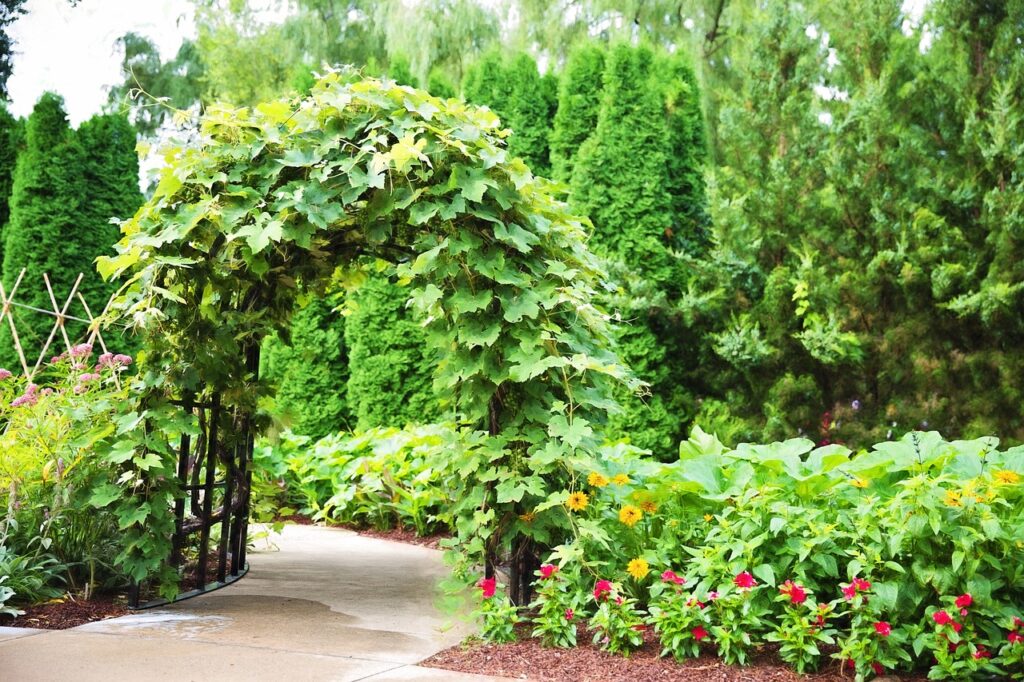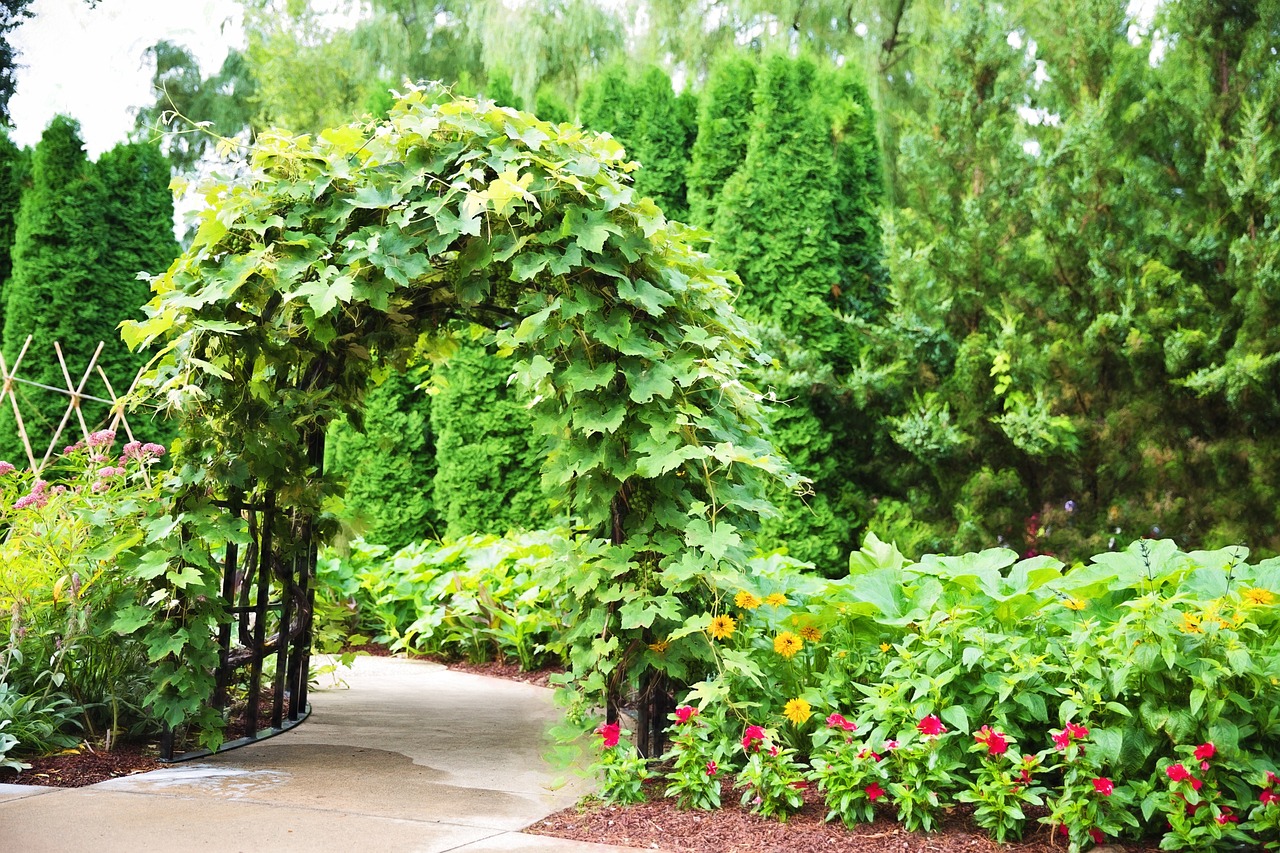Vertical gardening is a creative way to add greenery to small spaces, whether it’s a small backyard, an apartment balcony, or an empty wall. These gardens make the most of limited space by growing plants upward rather than outward. Here are some vertical garden ideas along with easy-to-follow plans to help you create your own green haven.
1. Living Wall Gardens
What It Is: A living wall, also known as a green wall, is a vertical garden where plants grow on a wall or a frame attached to a wall. This type of garden not only looks beautiful but also improves air quality and can help keep buildings cooler.
Garden Plan
- Building the Frame: Start by setting up a vertical frame or panel. You can buy a pre-made system or create one yourself using a wooden or metal frame with pockets or shelves for plants.
- Picking Plants: Choose plants that do well in the light conditions where your wall is located. Plants like ferns, succulents, and herbs work well. You can also include flowers like petunias or impatiens.
- Watering: Install a drip irrigation system at the top of the wall to water the plants evenly, or water them by hand with a long-spout watering can.
- Planting: Place your plants in the pockets or containers on the wall. Arrange them so that larger plants are at the bottom and smaller, trailing plants are at the top to create a cascading look.
- Maintaining: Keep an eye on your plants, prune as needed, and ensure the irrigation system is working properly.
2. Pallet Vertical Garden
What It Is: A pallet vertical garden is a simple and rustic way to create a vertical garden using an old wooden pallet. It’s perfect for growing herbs, flowers, or even small vegetables.
Garden Plan
- Preparing the Pallet: Clean the pallet and sand it to remove rough spots. You can paint or stain it to match your outdoor decor if you like.
- Planting Sections: Turn the pallet so the slats are horizontal. You can either leave the back open or attach landscape fabric or plywood to hold the soil in place.
- Filling with Soil: Fill the sections between the slats with potting soil, making sure the soil stays secure.
- Choosing Plants: Herbs like basil, thyme, and rosemary are great choices, as are flowers like marigolds and pansies. You can also grow small vegetables like lettuce or spinach.
- Planting: Plant your chosen plants in the gaps between the slats, making sure they have enough soil and are secure.
- Placement: Lean the pallet against a wall or secure it to a fence. Make sure it’s in a spot that gets the right amount of sunlight for your plants.
- Caring for Your Garden: Water regularly and trim the plants as needed to keep them healthy and neat.
3. Hanging Planter Garden
What It Is: A hanging planter garden uses hanging pots or baskets to create a vertical garden. It’s ideal for balconies, patios, or any area where you want to add greenery without taking up floor space.
Garden Plan
- Choosing Materials: Pick hanging planters or baskets that match your style. You could use macramé hangers for a boho look or metal chains for a more modern vibe.
- Installing Hooks: Secure sturdy hooks or brackets on the ceiling, wall, or balcony railing to hang your planters. Make sure they can support the weight of the plants.
- Selecting Plants: Trailing plants like ivy, pothos, or ferns are perfect for hanging planters. Herbs like mint or oregano also work well.
- Planting: Fill the planters with potting soil and plant your greenery. Water the plants thoroughly after planting.
- Arranging: Hang the planters at different heights to create visual interest, or group them together for a fuller look.
- Caring for Your Plants: Make sure the planters are easy to reach for watering and occasionally rotate them for even sunlight exposure.
4. Trellis Garden
What It Is: A trellis garden uses a trellis to grow climbing plants vertically. This method is great for growing vines, flowers, or vegetables like tomatoes and cucumbers.

Garden Plan
- Selecting a Trellis: Choose a trellis made of wood, metal, or plastic, depending on your preference. It should be strong enough to support the weight of your plants.
- Placing the Trellis: Position the trellis in a sunny spot. If you’re placing it against a wall, leave some space for air circulation.
- Picking Plants: Climbing plants like jasmine, morning glory, or clematis are great choices. You can also grow vegetables like beans, peas, and cucumbers.
- Planting: Plant your seeds or young plants at the base of the trellis. As they grow, gently guide the stems onto the trellis and secure them with garden ties if needed.
- Supporting Growth: Check regularly to ensure the plants are attaching to the trellis properly. Prune them to keep the garden tidy.
- Maintenance: Water regularly and provide support as needed. Harvest vegetables promptly to encourage continued growth.
5. Gutter Garden
What It Is: A gutter garden uses old gutters to create a unique, space-saving vertical garden. This is ideal for growing shallow-rooted plants like herbs and leafy greens.
Garden Plan
- Preparing the Gutters: Clean old gutters and drill drainage holes along the bottom to prevent water from pooling.
- Installing the Gutters: Attach the gutters to a wall, fence, or wooden frame at different heights. Make sure they are secure and slightly tilted to allow water to drain.
- Filling with Soil: Fill the gutters with well-draining potting mix and plant herbs like parsley, cilantro, and chives, or leafy greens like lettuce and spinach.
- Watering: Water regularly to ensure the plants in all levels get enough moisture. The drainage holes will prevent overwatering.
- Maintaining Your Garden: Harvest herbs and greens regularly to encourage new growth. Keep the gutters clean and free of debris.
Conclusion
Vertical gardens are a great way to add greenery to your space, especially when you’re short on room. Whether you choose a living wall, a pallet garden, hanging planters, a trellis, or a gutter garden, these simple plans will help you create a beautiful and functional vertical garden. With regular care, your garden will thrive and bring a touch of nature to your home.

